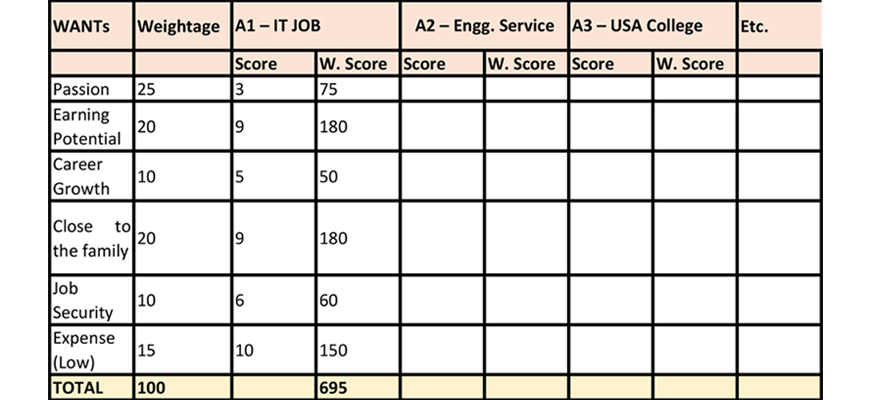“Job or Higher Studies, If job, IT Job or Core, If higher studies, in India or outside India? Choices keep increasing as I keep talking to more people”.
“You are getting confused between Decision Criteria and Decision Alternatives. That is why you are not able to take a decision. These are alternatives and not criteria”, Balram is cryptic. Srinivas gives an impression that he is not able to understand.
“Ok. I shall unravel the mystery myself. Decision criteria in your case is to decide on the right option so that your future is safe, happy and secure”. “Is this the right criteria?”, Balram waits for an answer.
Srinivas nods his head instead of replying.
“What are your MUSTs and WANTs?” Balram fires his next salvo.
“I want peace. That is all I know. I don’t know what are you asking”
“The fundamental difference between ‘must’ and ‘want’ is that if one of the decision alternatives does not satisfy a "must", then that option should be summarily rejected, and it is no longer an alternative. Failure to meet a "want" is not preferred but does not warrant automatic rejection.”
“I am still not getting” Srinivas is seen scratching his head.
“You filter your alternatives with MUSTs and summarily drop the alternatives if they don’t meet the MUSTs. You screen the rest of the alternatives against the WANTs” Balram looks at Srinivas to check if he is understanding.
“I am getting it now. MUSTs here is that total expense should not exceed my limit. I should not ask money from my father”.
“That is good. Write it here under MUSTs”, Balram writes it on a whiteboard in his room. Being good in organizing, he keeps a small whiteboard and a marker pen attached to the whiteboard in his study room.
“Now list the alternatives here and strike out the alternatives which do not satisfy the MUSTs. Which alternatives are going out at this stage?”, Balram questions.
“There are these two good colleges in the USA but I would not get scholarship. I don’t want to trouble my father. They are going out”, Srinivas strikes out the alternatives.
“List the WANTs now”, Balram throws the marker back to Srinivas.
“My Passion is top most, then Earning Potential, Career Growth, Job Security, hmm, “Srinivas starts thinking deeply.
“Think. Rack your brain. This step is very important in Decision Making so that you don’t miss any point. It is difficult to revisit your decision once a decision is made”.

Table 1 : Sample KT Analysis Template

“Acceptance in marriage market”, Saradha chips in. She is very worried that many of her relatives are not getting suitable brides for their boys. Getting a girl is becoming difficult nowadays.
“Don’t disturb Ma. This is not the time for jokes”, Srinivas turns his mother attention to the interesting discussion.
“Studying in the USA will enable me to earn in $ rather than salary in rupees” Srinivas spurts out.
“Which you have already considered as a WANT. See here.” Balram underlines Earning Potential. Your WANTs should not be repetitive and arbitrary. That will confuse the methodology”, Balram explains.
“I can suggest one more. Like your passion, there is a pride of serving your nation. Staying close to your family and helping them in times of their need is also a WANT. I am not saying this is a MUST. Is it not a WANT? Minimum?” Balram smiles.
“Definitely. Nobody told me so clearly. Thanks uncle. Please include it as a WANT. Write it in the first line” Srinivas is very enthusiastic.
“Not necessary. It is OK to write in the order of your thinking. KT also includes the method to rank your WANTs, don’t worry about it right now. Just write all that you can think of as WANTs”
“That is all I can think of Uncle”, Srinivas gives up.
“OK, let us move forward to the next step. Next step is to rank your WANTs. This is done by assigning a weightage in the order of importance to you such that the sum of the weightages of all the listed WANTs comes to a round number Let us take 100 for our case”, Balram writes a column heading ‘Weightage’ next to the WANTs column and asks Srinivas to write the weightages against each WANT.
“Remember, you should not include the MUSTs here and you should have already removed the alternatives which do not satisfy the MUSTs”, Balram clarifies.
Srinivas gets interested in the method. He puts some weightages but the sum does not come to 100. He erases the weightages and redistributes the shortage and finally brings the total to 100.
“Are you sure this looks rational for you? Remember rationality of your decision making depends on the rationality of weightage distribution”.
“I am sure”, Srinivas replies confidently.
“Now the next step; list all your remaining alternatives, after removing those which did not satisfy the MUSTs, as columns and write ‘Score’ and ‘Weighted Scores’ below each remaining alternative”. Balram writes the column headings (as in the Table 1. Only 3 alternatives shown in Table 1, whereas all 7 to be written) and gives the marker pen to Srinivas.
Srinivas is smart and hence able to understand the logic and gets further interested in the method. He starts writing but gets a doubt “Do I have to write the alternatives in the order of preference”.
Balram laughs “You came to me because you are not able to order the alternatives in terms of your preference. KT method is going to help you to find out the order of your preference. If you already know the order, we don’t need this session at all”.
Srinivas understands his folly and writes the alternatives he can think of
- Take an IT job in the campus placement
- Look for a government job in engineering, Prepare for engineering service exam
- Prepare for UPSC
- Prepare for GATE exam and do post-graduation in a reputed IIT
- Prepare for CAT and do management in IIM
- Post-graduation in the USA
- Post-graduation in a Singapore college
He stops with 7 and comments “7 is too many”
“Not at all, write as many as you want so that the decision making would become optimum. KT does not put any upper limit. You can have as many alternatives as you want”, Balram gives the pen back to Srinivas.
“No Uncle, enough”, Srinivas passes it back to Balram.
“Keep the pen with you only. You are going to do everything hereafter and not me”, Balram smiles.
“Now write a score within 1 to 10 against the combination of each alternative and each WANT in the Score columns. Make an honest scoring based on your judgement. Your bias for an alternate should not influence the score. Think of all possible justifications before putting a number”, Balram explains.
“Like ‘Close to the family’ would be the best if I take a ‘campus job’ and hence I would give 9 for that alternative against that WANT”, Srinivas writes 9 in that intersection.
“You got it very correct. Now fill up all the boxes in all the score columns”.
Srinivas fills up the boxes (Completed for only one alternative in the table). He is not able to decide a score for some boxes and asks Balram for help. Balram refuses to give a number but shares his opinion whenever Srinivas is not able to conclude. Srinivas is able to complete all the boxes after spending 15 minutes and a cup of coffee in between.
“Now multiply each score by the weightage written in that row and put the result under the column ‘Weighted Score’ next to ‘Score’ column”, Balram makes one sample calculation and gives the pen back to Srinivas. Srinivas completes all the boxes under the columns ‘Weighted Score’.
“Your confusion is over now. You have your answer now. Do you want to know the answer to your puzzle” Balram is very enthusiastic now?
“Where is the answer Uncle? I am not seeing any answer” Srinivas is puzzled.
“Just sum each of the ‘Weighted Score’ columns and that is the total score for each alternative. Rank the alternatives in the descending order of the total of the weighted scores and you have your decision preference in descending order”.
“Superb. This is magic, KT magic. Do you want to know which alternative has won?” Srinivas is not able to express his happiness!
Balram walks out of the room by muttering “Not required. It is your decision, and I am sure you have taken the right decision. I don’t need to know that decision. Just keep in mind this great saying which I consider close to my heart always”.
“No Decision is RIGHT or WRONG. What matters is the action that follows the choice”.
“Go behind your decision, right from now and never regret taking that decision. You should be confident that KT enabled you to take the right and conscious decision. You might change your course but not retract your path”. Balram walks out his room saying this.
Balram re-enters saying “Remember to take me out for a nice dinner”.
About the Author
Jaganathan T is the Managing Director of IT Services company FutureCalls Technology Private Limited. Jaganthan is an accomplished author and motivational speaker by passion. He has written and published two books ‘Management Immemorial – Learnings from Literature’ and ‘Grandma in The Board Room’. Author can be reached at authorjagan@gmail.com.